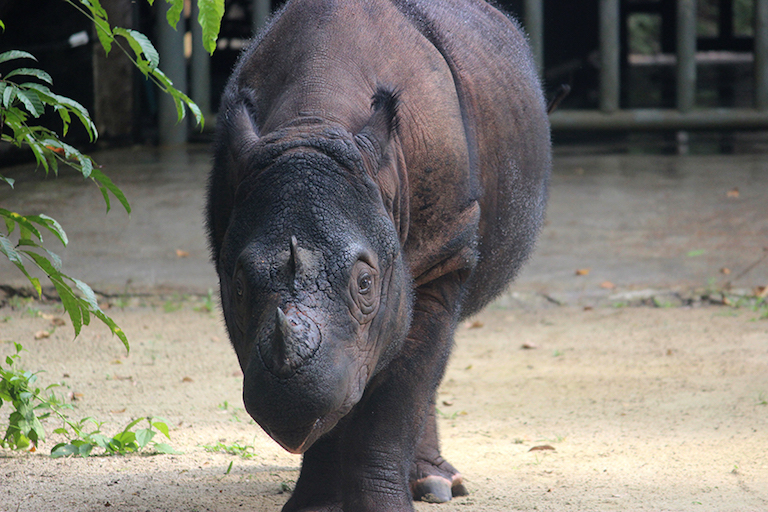- Only 50-100 Sumatran rhinos are believed to remain. Seven live at the Sumatran Rhino Sanctuary in Indonesia.
- One of the sanctuary’s residents, Harapan, was transferred from the Cincinnati Zoo two years ago.
- Harapan’s caretakers say he is in good health, is settling into the facility and will soon be introduced to one the center’s female rhinos in hopes of siring offspring.
Harapan, a Sumatran rhino (Dicerorhinus sumatrensis) born in captivity in the United States, has now been living for almost two years at the Sumatran Rhino Sanctuary (SRS) in Indonesia’s Way Kambas National Park.
As a representative of one of the world’s rarest and most endangered mammal species, Harapan’s wellbeing in Indonesia has been a source of interest and concern for conservationists and animal lovers around the world.
According to his current caretakers, Harapan — whose name means “hope” in Indonesian, although his fans in America often called him Harry — appears to have settled in well since arriving from the Cincinnati Zoo in November 2015.
“Harapan is already independent,” said Zulfi Arsan, the facility’s lead veterinarian. “He has adapted to the surrounding environment like other rhinos at the SRS. His activities, such as wallowing and foraging, are all normal.”
Harapan’s initial three-month quarantine period went off without a hitch, Arsan said. After spending his formative years in a zoo, the rhino is getting used to the wide variety of natural fodder available at the fenced-in facility, and now weighs in at a healthy 780 kilograms (1,720 pounds).
Now, his caretakers hope Harapan will be able to contribute to the survival of his species by fathering offspring with one of the female rhinos at the SRS.

The total global population of Sumatran rhinos is estimated at somewhere between 50 and 100 individuals. Seven of those now live at the SRS, including Harapan’s brother Andalas, who was transferred to the facility in 2007.
Since his arrival, Andalas and a female rhino named Ratu have produced two calves: Andatu (male) in June 2012 and Delilah (female) in May 2016. The birth of these two healthy calves has been a source of much-needed optimism for the future of the species.
The wild Sumatran rhino population declined massively in the 20th century, due to both hunting and habitat loss. In response, zoos in Southeast Asia, Europe and the United States launched a captive breeding program. Starting in 1984, a total of 40 rhinos were captured from Indonesia and Malaysia and distributed among participating zoos.
By 2000, no calves had been born and almost all of the rhinos held in zoos had died — some due to old age, but many due to gastrointestinal disorders and other health problems. Three of the survivors – Torgamba, Bina and Dusun – were sent to the SRS, while a pair remained in Cincinnati.

Finally, in 2001, Andalas was born to the Cincinnati Zoo’s rhinos — the first known captive Sumatran rhino birth in over a century. A female calf named Suci followed in 2004, then Harapan in 2007.
By 2014 three of the rhinos at the Cincinnati Zoo had died. Ipuh, the father, succumbed to thyroid cancer, while Suci and her mother Emi died of of iron-storage disease or hemochromatosis, prompting zookeepers in Ohio to agree to Harapan’s transfer to SRS. “This condition (hemochromatosis), occurs in rhinos ‘cared for’ in zoos. This is because of limited feed, especially in terms of quantity and variety,” Arsan said.
The staff at SRS argue that living in conditions as close as possible to their natural habitat is critical to avoiding such problems. Harapan showed signs of suffering from the same metabolic disorder, but living at SRS and consuming his species’ natural diet should improve his condition, Arsan said.
Other potential health concerns for Harapan and the other rhinos at SRS include gastrointestinal infections like E. Coli or Salmonella, and parasites including the deadly blood-borne Trypanosoma evansi.
“These diseases are not specific to rhinos, but can be transmitted between them. For Trypanosoma, it requires vector animals, which are blood-sucking flies that can transmit the disease from a sick animal to a healthy one,” Arsan said.
To counter these threats, the rhinos at SRS get weekly heath check-ups and regular doses of de-worming medications.

With Harapan in good health, attention has now turned to finding him a mate among the three females at the SRS: Ratu, Rosa and Bina. The sanctuary’s staff have been working to determine who holds the most attraction for Harapan by observing his response to urine sprayed on leaves by each of the females. “As it turns out, Harapan is most interested in urine from Ratu,” said Arsan.
The sanctuary is now making plans to introduce Ratu to Harapan, in hopes that his apparent interest in the female will lead to a natural mating. “We hope this will happen as soon as possible,” Arsan said.

This story was reported by Mongabay’s Indonesia team and was first published on our Indonesian site on Sept. 22, 2017.
FEEDBACK: Use this form to send a message to the author of this post. If you want to post a public comment, you can do that at the bottom of the page.
Banner image: Harapan appears to be thriving on varied diet of natural foliage. Photo by Rahmadi Rahmad/Mongabay-Indonesia.
Correction: this article has been updated to reflect the fact that Ipuh, Harapan’s sire, died of thyroid cancer rather than iron-storage disease.













